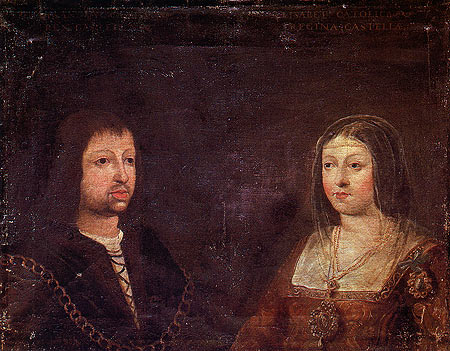To put things into perspective man has to know about the past. From the Romans to the present day, Spain has played an important role in the progression of the Western World. InSpain.news gives a resume of the history of Spain based on several (scientific) sources. This is part 7. Read parts 1 here, 2 here, 3 here, 4 here, 5 here and 6 here.
In the 15th century, four Christian kingdoms, Navarre in the north, Portugal in the west, Castile (in 1230 definitively united with León) in the centre and Aragon on the Mediterranean coast, shared the territory of the Iberian Peninsula. The kingdom of Granada in the south was Islamic.
Marriage of ‘los Reyes Catolicos’
Modern Spain thanks its creation to the marriage of Ferdinand of Aragon and Isabella of Castile in 1469. They received the title ‘Los Reyes Catolicos’ from Pope Alexander VI. The two kingdoms together now had the vast majority of the territory of the Iberian Peninsula. Portugal would remain independent, except between 1580 and 1640. The Basque Navarre remained an independent kingdom until the early 16th century.
The Spanish economy under the reign of Ferdinand and Isabella was based on an efficient tax collection system, agriculture and the export of wool. In order to defend the wealth brought in by wool, the Kings granted privileges to the powerful Mesta (sheep farmers) by giving them control of the drover’s roads (Cañadas). In Burgos, where the most important wool market was situated, the building of the gothic cathedral was largely funded by the Mesta.
Surrender of Granada: The legend of El Suspiro del Moro
The Reconquista proceeded in varying intensity, with everchanging front lines and successes, for 770 years. The surrender of Granada to Los Reyes Catolicos in 1492 was the definitive moment. Travelling from the Alhambra in the direction of Motril (on the Spanish south coast) we find, between the towns of Otura and El Padul, a kilometre point called ‘El Suspiro del Moro’.
According to legend, the catholic monarchs could raise their flags in the kingdom of Granada without encountering any significant resistance from the Moors. The last king of Granada, Boabdil, went into exile. Together with his entourage, he set out on his way south.
During this painful journey, already far away from the majestic Alhambra, Boabdil stopped on a hill. From there he looked back one last time, sighed and began to cry over what he had lost. His mother, Aixa, reprimanded him with the famous words: “you cry like a woman over what you could not defend as a man”. The point at which he stopped is ‘El Suspiro del Moro’ – the sigh of the Moor.
1492 – a year to remember
1492 is a crucial year in Spanish history. There is a definitive end to the Islamic empire on Spanish territory. Spain becomes a Catholic kingdom, a theocracy. The country is being purified from Jewish and Islamic influences, and the Catholic Church is given a powerful position.
Also in 1492, Columbus explored and discovered America. An important motive for this trip was the mission of Los Reyes Catolicos to spread the Catholic faith around the world – the explorations really a crusade against the “unbelievers”. The South American Indians were converted with violence and robbed of their gold and silver. This haul yielded Spain immense riches and prosperity.



